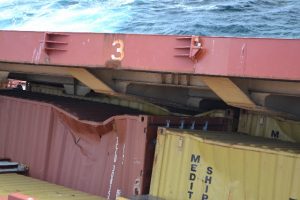
Containers can be seen pushing up the hatch covers in the bow section – photo credit LOC
Clearly, the proper, adequate and satisfactory stowage and securing of cargo is of the utmost importance for the safety of crew, ship and cargo itself. If not properly carried out, cargo might shift with consequences such as widespread cargo damage, loss overboard, pollution and injury and even fatalities and sinkings.
These prospects were spelled out by Adrian Scales of Brookes Bell Group at a seminar organised by the London Shipping Law Centre Maritime Business Forum at Squire Sanders’ London office on April 30th.
He was presenting a technical perspective on cargo stowage and safety issues, with particular reference to securing general and timber deck cargoes.
Among a host of international codes and regulations, he highlighted the SOLAS (International Convention for the Safety of Life at Sea) requirement that ships—-other than those carrying solid and liquid bulk cargoes—-must have on board an approved Cargo Securing Manual (CSM).
This provided guidance for the safe carriage of all cargo items for which the ship was designed. Was it suitable for carrying such a cargo in deep sea and demanding weather? Crew needed to be familiar with the contents which, in turn, had to reflect the International Maritime Organization Code of Safe Practice for Cargo Stowage and Securing 2011. In the absence of any other guidance on timber deck cargoes, this Code would apply.
Despite codes of safe practice and publications on safe stowage and securing, however, incidents continued to occur.
Mr. Scales pointed out that pitch, sway, yaw, heave, roll and surge affected ship stability. To cope with this, the right lashing material was essential, given the size, weight and type of cargo, supplemented by appropriate dunnage. “They must prevent the cargo from moving as the ship rolls and pitches in the seaway.”
The CSM Code laid down the vital role of Maximum Securing Loads for shackles, rings, deckeyes, turnbuckles of mild steel, fibre and wire rope, web lashings, steel bands and chains.
The Rule of Thumb and Advanced Calculation methods should establish whether the chosen lashings would work properly throughout a voyage.
For loading timber deck cargoes, owners, charterers and masters needed to satisfy themselves that a vessel was suitably equipped and arranged, could carry the full weight and met all stability criteria, including where appropriate, racking requirements for sawn timber.
Mr. Scales itemised instances of haphazard stowing and securing. The main culprits were poor dunnage and excessive loads on lashings, D-rings and turnbuckles—-sometimes many times too much. Containers and large items had been lashed together rather than secured to proper points. This did not count as lashing at all.
He referred to instances of basic requirements for securing timber deck cargoes being overlooked, sometimes with huge consequences. One sinking had resulted in two fatalities and timber washed ashore over 20 miles of beach.
Investigations into various incidents had highlighted considerable shortcomings. Charterers and shippers had been ignorant about relevant publications while providing a limited or no pre-loading plan. This had produced poor and inadequate stowage arrangements; poor quality dunnage; poor placement and arrangement of lashings and their location on ships’ structures; and an excessive reliance of wires over the full stow.
Crew knew little about weights relative to Maximum Securing Loads, the Master’s responsibilities under the charterparty, the CSM Code, the Cargo Securing Manual and the Timber Deck Cargo Code. There had been an over reliance on appointed Supercargoes and insufficient understanding of who was responsible for which parts of full stowage and securing operations.
Mark Williams, Loss Prevention Director, West of England Insurance Services, also stressed the SOLAS requirement that cargo be stowed and secured to prevent damage to any item or structure, hazards to ship and personnel and cargo falling overboard.
Total Maximum Safe Load values of securing devices on each side of cargoes should equal the unit’s weight. All lashings should be in good condition, positioned and applied correctly, balanced and not exposed to wear or abrasion. Responsible parties still had consider whether these measures would be enough for deck cargo, given likely voyage conditions.
Shortcomings in practice and underlying knowledge had sometimes produced devastating consequences. Overloading of rolled and slab steel cargoes had crushed the lowest units, having broken through inadequate dunnage. The collapse of a paper pulp stow had produced ‘knock on’ instability with containers being lost overboard.
Inadequately secured roller trailers, semi-trailers and paper reels had come loose and capsized a ship in a heavy following sea in the Baltic. Here, the charterers had used their own securing system which was below CSM standard. CSM compliance checks by Flag and Port State Control had been non-existent. Owners showed no real knowledge of cargo securing in the first place while officers’ requests for cargo securing training had been unheeded.
Mr. Williams pointed out that within the extensive training requirements for seagoing officers, that devoted to securing and stowage was minimal.
Dealing with legal problems arising from cargo stowage incidents, Graham Harris, a partner in Squire Sanders, said that stowage and securing arrangements were governed by the New York Produce Exchange or Gencon forms.These encompassed the relative responsibilities of owners and charterers re loading, stowing and securing.
Under Common Law, owners were responsible for all cargo operations, unless varied by agreement. It was sometimes possible to transfer responsibility for stowage to charterers, taking into account supervision by the master and the vessel’s seaworthiness. There was a difference between a vessel being unseaworthy per se and becoming so because of a bad stow.
Mr. Harris outlined the problems arising from simply incorporating the charterparty into the bill of lading. Deck cargo was broadly carried at the charterer’s risk but owners remained liable for loss caused by actionable unseaworthiness or crew negligence.
The Hon. Mr Justice Hamblen chaired the seminar which was introduced by Dr Aleka Mandaraka Sheppard, Chairman of the London Shipping Law Centre.





